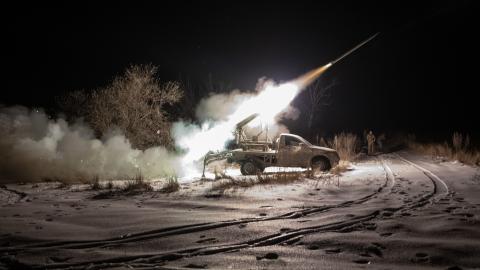Below Hudson Senior Fellow Can Kasapoğlu offers a military situation report about the war in Ukraine.
Executive Summary
- Russia has likely begun to use the jet-powered variant of the Iranian Shahed loitering munition baseline, presaging further troubles for Ukrainian air defenses.
- Ukraine has recently employed a human-out-of-the-loop, autonomous drone warfare system in combat operations.
- The Russian military has been gaining the upper hand in the artillery-driven, highly attritional war, with Ukrainian territorial losses remaining at a tactical scale but subject to rapid deterioration in the absence of adequate Western assistance packages.
1. Battlefield Assessment
As of January 8, 2023, the main Russian assault axes remain centered on the southeastern and eastern portions of the front line, focused on capturing the unoccupied parts of Luhansk and Donetsk Oblasts. Russian forces continue to mount a subordinate effort on the southern front, where their combat formations are deployed in the vicinity of Zaporizhzhia. In the east and the southeast, Ukrainian forces suffer increasing losses each week amidst gradually increasing Russian pressure. The southern sector is stable, with neither party making tangible gains there.
An analysis of the Russian information space suggests that Russia is using heavy artillery salvos across almost all fronts, especially in Avdiivka and along the Robotyne–Verbove axis. While territorial changes have yet to occur at the strategic level, the increase in artillery fire can be attributed to Pyongyang’s assistance. Should the Russian military maintain its slow but attritional momentum—and should Kyiv fail to receive additional munitions from its Western suppliers—the Ukrainian lines of defense may become vulnerable to severe breaches. Ukraine’s worsening artillery disadvantage could also deepen its problems in such an artillery-driven conflict where maneuver formations are restricted.
Another mismatch between Russia and Ukraine is evident in the electronic warfare theater. As Ukraine’s chief of staff, General Valery Zaluzhny, recently admitted, Russia’s military outclasses Ukraine’s in introducing new and capable electronic warfare equipment to the battleground. This imbalance inevitably translates into asymmetries in drone warfare, producing additional impediments to Ukraine’s robotic warfare solutions.
Nonetheless, Ukraine is using all means at its disposal to offset the overwhelming pressure of the Russian onslaught. In the last few weeks, Ukrainian forces successfully struck several high-value Russian assets, including a Ropucha-class landing ship and several other critical military facilities. Russian official sources acknowledged that these attacks mostly featured loitering munitions and cruise missiles, including Britain’s combat-proven Storm Shadow and Kyiv’s indigenous long-range strike asset, the Neptune missile family.
In the meantime, Russian aerial assaults continued, with a two-wave Shahed kamikaze drone and missile attack overnight on January 5. According to the Ukrainian Air Force, most of these aerial strikes concentrated on Kherson, Mykolaiv, and Kharkiv Oblasts. Official statements suggest that Ukraine successfully intercepted 21 out of 29 loitering munitions over Mykolaiv. Yet overall interception rates remained relatively low over Kherson Oblast. In the Kherson sector, multiple Russian missiles and kamikaze drones breached Ukraine’s defenses. On January 7, local sources reported a large-scale aerial attack that damaged housing in a civilian neighborhood in Sumy.
Worryingly, Western F-16 transfers to the Ukrainian Air Force are supposedly facing delays, with local news reports hinting at a waiting period of around six months, reportedly due to the unpreparedness of Ukrainian personnel. Postponing the much-needed upgrade of Ukraine’s air-power capabilities will most likely leave Kyiv vulnerable during a possible reloaded counteroffensive that could occur in summer 2024.
2. Russia Is Likely Using Jet-Powered Shahed Drones in Ukraine
Open-source intelligence suggests that Russia’s strike packages in Ukraine now include the jet-powered variants of the Shahed loitering munition baseline. Dubbed the Shahed-238, this kamikaze drone features increased speed, multiple guidance options, and greater payload capacity. Its potent combination of battlefield features could mean trouble for Ukrainian air defenses.
Like the modified versions of Shahed-131 and Shahed-136, reports suggest that the Shahed-238 may also possess a dark, radar-emitting composite coating. Evidence hints that the drone’s engine might be derived from the TEM Tolue-10, an Iranian clone of the Czech PBS Aerospace TJ-100. This same engine DNA also reportedly flies the Iranian Quds-1 and Ya-Ali cruise missiles, which the Houthis used in their attacks on ships in the Red Sea.
The Shahed-238 will likely have implications for Ukraine’s military as it creates demand for high-end air defenses. As the winter war has intensified, Ukraine has faced air defense pressure amidst overwhelming Russian salvos. The new Iranian drone will amplify this pressure and increase Ukraine’s need for air defense munitions and missiles capable of facing the threat. In the absence of Western aid, this could place an additional strain on Ukraine’s already fragile arms and ammunition stocks.
3. Ukraine Is Employing Autonomous Drone Warfare System in Combat Operations
Last week, news outlets reported that Ukraine deployed the Saker Scout drone, a rotary-wing unmanned aerial vehicle (UAV), in autonomous, human-out-of-the-loop combat operations. This marks a milestone, as it is the first verified use of fully autonomous UAVs in battle. According to the drone’s manufacturer, the Saker Scout can use advanced machine-learning features to independently detect, identify, and engage 64 different types of Russian military targets. The drone also comes with an important electronic warfare immunity edge, a critical advantage in the Ukrainian battle space. The UAV possesses an effective range of 12 kilometers (roughly 7.4 miles) and can carry up to 3 kilograms (roughly 6.6 pounds) of explosives, including modified RKG-3 anti-tank grenades and rocket-propelled grenade warheads.
The Saker Scout drone is not a lone wolf, but a network- and data-centric asset. It is integrated into Ukraine’s cutting-edge Delta intelligence system, which operates as a data fusion node, harvesting information from drones and satellites to produce a real-time and highly sensitive battle map. Its overall architecture bears the burden of identifying adversarial weapons systems, freeing up hundreds of intelligence analysts to focus on other matters.
While the Ukrainian military faces growing challenges—especially if Western arms transfers are to decline—Kyiv continues to provide glimpses of the defense technologies of tomorrow.


















